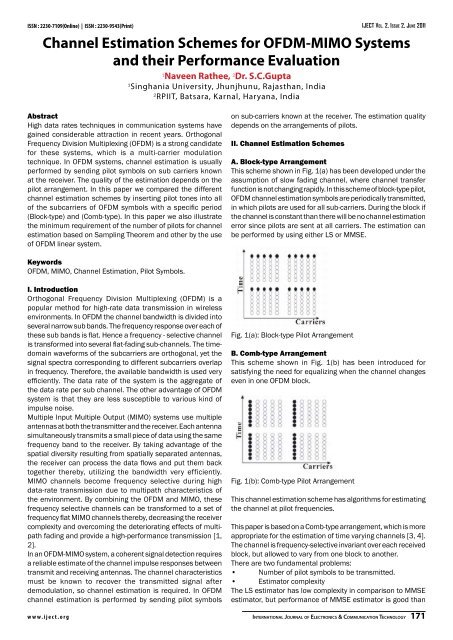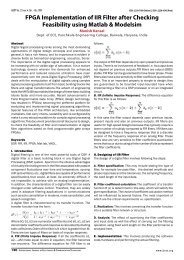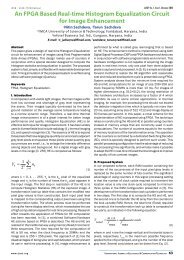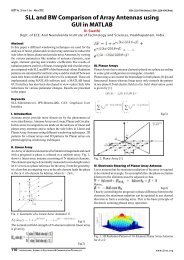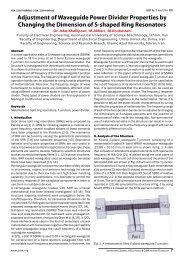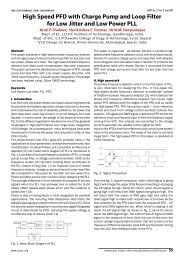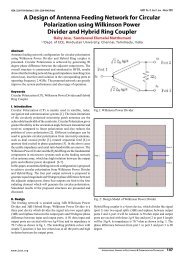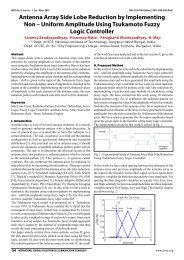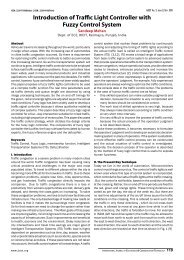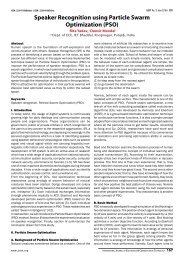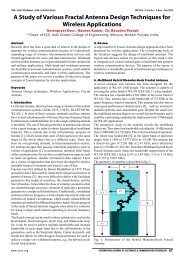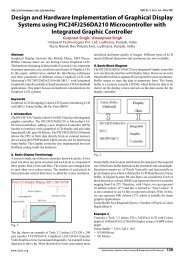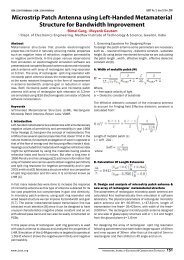Channel Estimation Schemes for OFDM-MIMO Systems and ... - iject
Channel Estimation Schemes for OFDM-MIMO Systems and ... - iject
Channel Estimation Schemes for OFDM-MIMO Systems and ... - iject
Create successful ePaper yourself
Turn your PDF publications into a flip-book with our unique Google optimized e-Paper software.
ISSN : 2230-7109(Online) | ISSN : 2230-9543(Print)IJECT Vo l. 2, Is s u e 2, Ju n e 2011<strong>Channel</strong> <strong>Estimation</strong> <strong>Schemes</strong> <strong>for</strong> <strong>OFDM</strong>-<strong>MIMO</strong> <strong>Systems</strong><strong>and</strong> their Per<strong>for</strong>mance Evaluation1 Naveen Rathee, 2 Dr. S.C.Gupta1Singhania University, Jhunjhunu, Rajasthan, India2RPIIT, Batsara, Karnal, Haryana, IndiaAbstractHigh data rates techniques in communication systems havegained considerable attraction in recent years. OrthogonalFrequency Division Multiplexing (<strong>OFDM</strong>) is a strong c<strong>and</strong>idate<strong>for</strong> these systems, which is a multi-carrier modulationtechnique. In <strong>OFDM</strong> systems, channel estimation is usuallyper<strong>for</strong>med by sending pilot symbols on sub carriers knownat the receiver. The quality of the estimation depends on thepilot arrangement. In this paper we compared the differentchannel estimation schemes by inserting pilot tones into allof the subcarriers of <strong>OFDM</strong> symbols with a specific period(Block-type) <strong>and</strong> (Comb-type). In this paper we also illustratethe minimum requirement of the number of pilots <strong>for</strong> channelestimation based on Sampling Theorem <strong>and</strong> other by the useof <strong>OFDM</strong> linear system.on sub-carriers known at the receiver. The estimation qualitydepends on the arrangements of pilots.II. <strong>Channel</strong> <strong>Estimation</strong> <strong>Schemes</strong>A. Block-type ArrangementThis scheme shown in Fig. 1(a) has been developed under theassumption of slow fading channel, where channel transferfunction is not changing rapidly. In this scheme of block-type pilot,<strong>OFDM</strong> channel estimation symbols are periodically transmitted,in which pilots are used <strong>for</strong> all sub-carriers. During the block ifthe channel is constant than there will be no channel estimationerror since pilots are sent at all carriers. The estimation canbe per<strong>for</strong>med by using either LS or MMSE.Keywords<strong>OFDM</strong>, <strong>MIMO</strong>, <strong>Channel</strong> <strong>Estimation</strong>, Pilot Symbols.I. IntroductionOrthogonal Frequency Division Multiplexing (<strong>OFDM</strong>) is apopular method <strong>for</strong> high-rate data transmission in wirelessenvironments. In <strong>OFDM</strong> the channel b<strong>and</strong>width is divided intoseveral narrow sub b<strong>and</strong>s. The frequency response over each ofthese sub b<strong>and</strong>s is flat. Hence a frequency - selective channelis trans<strong>for</strong>med into several flat-fading sub-channels. The timedomainwave<strong>for</strong>ms of the subcarriers are orthogonal, yet thesignal spectra corresponding to different subcarriers overlapin frequency. There<strong>for</strong>e, the available b<strong>and</strong>width is used veryefficiently. The data rate of the system is the aggregate ofthe data rate per sub channel. The other advantage of <strong>OFDM</strong>system is that they are less susceptible to various kind ofimpulse noise.Multiple Input Multiple Output (<strong>MIMO</strong>) systems use multipleantennas at both the transmitter <strong>and</strong> the receiver. Each antennasimultaneously transmits a small piece of data using the samefrequency b<strong>and</strong> to the receiver. By taking advantage of thespatial diversity resulting from spatially separated antennas,the receiver can process the data flows <strong>and</strong> put them backtogether thereby, utilizing the b<strong>and</strong>width very efficiently.<strong>MIMO</strong> channels become frequency selective during highdata-rate transmission due to multipath characteristics ofthe environment. By combining the <strong>OFDM</strong> <strong>and</strong> <strong>MIMO</strong>, thesefrequency selective channels can be trans<strong>for</strong>med to a set offrequency flat <strong>MIMO</strong> channels thereby, decreasing the receivercomplexity <strong>and</strong> overcoming the deteriorating effects of multipathfading <strong>and</strong> provide a high-per<strong>for</strong>mance transmission [1,2].In an <strong>OFDM</strong>-<strong>MIMO</strong> system, a coherent signal detection requiresa reliable estimate of the channel impulse responses betweentransmit <strong>and</strong> receiving antennas. The channel characteristicsmust be known to recover the transmitted signal afterdemodulation, so channel estimation is required. In <strong>OFDM</strong>channel estimation is per<strong>for</strong>med by sending pilot symbolswww.<strong>iject</strong>.orgFig. 1(a): Block-type Pilot ArrangementB. Comb-type ArrangementThis scheme shown in Fig. 1(b) has been introduced <strong>for</strong>satisfying the need <strong>for</strong> equalizing when the channel changeseven in one <strong>OFDM</strong> block.Fig. 1(b): Comb-type Pilot ArrangementThis channel estimation scheme has algorithms <strong>for</strong> estimatingthe channel at pilot frequencies.This paper is based on a Comb-type arrangement, which is moreappropriate <strong>for</strong> the estimation of time varying channels [3, 4].The channel is frequency-selective invariant over each receivedblock, but allowed to vary from one block to another.There are two fundamental problems:• Number of pilot symbols to be transmitted.• Estimator complexityThe LS estimator has low complexity in comparison to MMSEestimator, but per<strong>for</strong>mance of MMSE estimator is good thanIn t e r n a t io n a l Jo u r n a l o f El e c t r o n ic s & Co m m u n ic a t io n Te c h n o l o g y 171
IJECT Vo l. 2, Is s u e 2, Ju n e 2011LS [5]. The <strong>OFDM</strong> transmission is robust to multi-path channeldelay, cyclic prefix is used to eliminate inter-symbol interference(ISI), but the inter-carrier interference is still a problem becauseof Doppler frequency. Orthogonality of the tones can’t bepreserved because of Doppler Effect [6] when the channelchanges even in one <strong>OFDM</strong> block in fast fading channels.In this paper we have studied the case of multipath fadingchannels with Orthogonality of tones being preserved alongwith optimal spacing of pilot symbols <strong>for</strong> <strong>OFDM</strong>-<strong>MIMO</strong> systems.The result of work based on channel capacity investigatingthis optimization problem [7] confirms the result of the studybased on the <strong>OFDM</strong> linear system (Y=HX+N), these studiesshow that in a multipath channel with L independent pathschannel estimation requires at least L symbols equally-spacedin the <strong>OFDM</strong> block.1. <strong>Estimation</strong> of <strong>Channel</strong> based on Comb-Type PilotArrangementThe received signal in an <strong>OFDM</strong>-<strong>MIMO</strong> system at the kth tonecan be expressed as:Y (k) = H (k) X (k) + I (k) + N (k), k = 0, 1 …N-1 (1)Where I (k) is the inter-carrier interference (ICI) because ofDoppler frequency.In case of multipath slowly fading channels, when channel isfrequency-selective invariant over each received block <strong>OFDM</strong>symbol, the Orthogonality between subcarrier can be preserved<strong>and</strong> so we can writeISSN : 2230-7109(Online) | ISSN : 2230-9543(Print)To fulfill the sampling theorem <strong>and</strong> avoid aliasing the pilotsymbols have to be close enough. There<strong>for</strong>e, using piecewiseinterpolation we can reconstruct the channel impulseresponse. Whereas, if in<strong>for</strong>mation about characteristics ofchannel is sufficient than the type of interpolation can bechoose even if pilot symbols are not close enough to fulfillsampling theorem.III. Minimum Pilot Tones RequirementIn this section we analyze the minimum requirement of pilots<strong>for</strong> channel estimation in <strong>OFDM</strong>-<strong>MIMO</strong> systems. Theoreticalanalysis shows that the channel estimation requires at least Lpilot symbols, <strong>and</strong> this statement can be proved by two differentmethods.• Sampling Theorem• <strong>OFDM</strong> linear system Y = HX+N.A. Sampling TheoremComb-type pilot arrangement channel estimation is based oninserting constant values (pilots) in some sub-carriers of the<strong>OFDM</strong> frame (Fig. 3). LS estimator gives estimation of channelat pilot sub-carriers after signal demodulation. The piecewiseconstant interpolation is used as shown in (Fig. 4). Hence,the process of estimation of channel based on pilot symbolswith piecewise constant interpolation is same as the samplingprocess. The bit-error-rate can be decreased if pilot symbols areplaced closer than that specified in the Sampling theorem.Y k,m= H k,mX k,m+ N k,m(2)Where Yk,m is the received signal; Xk,m is the transmitteddata <strong>and</strong> Nk,m is the AWGN noise. Because of the reason ofcomplexity there are several channel estimation criteria used,the estimation can be per<strong>for</strong>med by using either linear MMSEcriterion (Wiener filtering) [8,9] <strong>and</strong> LS criterion. However LScriterion offers a good per<strong>for</strong>mance/complexity in high SNRregimes <strong>and</strong> when the noise level is low.2. InterpolationAn interpolation technique is necessary in order to estimatechannel at data sub-carriers by using the in<strong>for</strong>mation of channelat pilot sub-carriers [10]. It is done using piecewise-constantinterpolation, linear interpolation, low-pass interpolation <strong>and</strong>other interpolation techniques. A comparison between threetypes of frequency channel response, Indoor A, Pedestrian B<strong>and</strong> Vehicular B is shown in Fig. 2 below.Fig. 3: Pilot InterpolationFig. 4: Sampling Process1. Modelling Multipath <strong>Channel</strong>The number of propagation paths determined by the ratio of themaximum delay spread τ max<strong>and</strong> the sampling period T sis theparameter on which the complexity of an estimator depends.In the analog domain the multipath channel is given by thecomplex-valued impulse response [11]:Fig. 2: Rayleigh model 2GHz, ETSI TR101-102172 In t e r n a t io n a l Jo u r n a l o f El e c t r o n ic s & Co m m u n ic a t io n Te c h n o l o g y(3)where αl is the complex gain of the lth path, τl is the propagationdelay <strong>for</strong> the lth path. In digital transmission systems, symbolsare transmitted in regular time interval T s, called the samplingperiod. This period is smaller than the maximum delay timeτ max.For most of the wideb<strong>and</strong> wireless systems, the discretewww.<strong>iject</strong>.org
ISSN : 2230-7109(Online) | ISSN : 2230-9543(Print)multipath model is regarded as the reference under anapproximation of constant number of multipath componentsL <strong>and</strong> slow variation of the delay values. The multipath channelis modeled as:Considering only the case whenplacement of pilot symbols.IJECT Vo l. 2, Is s u e 2, Ju n e 2011is an integer <strong>for</strong> equispacedThe path gains are given as samples which are taken at differentintervals Ts. The discrete signal spectrum is a periodic signal.Since inter-carrier spacing is ∆f <strong>and</strong> T=N.Ts is the duration ofan <strong>OFDM</strong> symbol, we have(5)In Comb-type pilot arrangement if it is assumed that pilots areplaced Nf subcarriers apart in every <strong>OFDM</strong> symbols <strong>and</strong> pilotsymbols are equally spaced <strong>and</strong> fe is the spacing between twoconsecutive pilot symbols then we have(6)Let He (f) be the frequency response of the channel constructedfrom the pilot symbols with a piecewise constant-interpolation.Then(4)Number _of_Pilot_Tones =Now knowing that is the number of pilot symbols in the<strong>OFDM</strong> frame, then the channel estimation requires at leastL pilot symbols.2. <strong>OFDM</strong> Linear System Y=HX+NWhen Orthogonality is preserved in the <strong>OFDM</strong> system, thesystem equation is expressed asY k,m= H k,mX k,m+ N k,m(13)Where N k,mis AWGN noise.Let there be the set of L tones used <strong>for</strong> transmitting pilotsymbols {k 1 , k 2 ,-----, k L }.If there is no noise, then from (13) we have:Y pl = H pl X pl (14)Where(7)(8)Inverse Fourier trans<strong>for</strong>m of this distribution is he(t) <strong>and</strong> iswritten as:(9)(10)(11)Since Q is a V<strong>and</strong>ermonde matrix with L parameters distinct,h can be found by inverting Q.From equation 13 we have L unknowns h 1 , ---h L . If L is thenumber of pilot symbols then the number of equations equalsthe number of unknowns, then the system can be solved. Ifthe symbols are less than L then number of equations willbe less than the number of unknowns <strong>and</strong> we will have anunder-determined system of linear equations, <strong>and</strong> hence anon-unique solution h.There<strong>for</strong>e in both the cases (in the absence of noise) theminimum number of pilot symbols is L <strong>for</strong> exact channelestimation.IV. Results of Simulation(12)Thus h(t) can be reconstructed from h e(t).Sampling period Temust be greater than channel impulse response <strong>for</strong> samplesto be close enough to fulfill sampling theorem <strong>and</strong> avoidaliasing.i.e. Te ≥ L.Ts where L.Ts is the length of the multipath channelimpulse response. Using equation 6 we have.A. Multipath <strong>Channel</strong> EffectFor analysis, an <strong>OFDM</strong> 16 QAM transmission over a multipathchannel in the absence of noise (4 paths, 6 paths <strong>and</strong> 10 paths)was tested with N = 256 subcarriers, <strong>and</strong> cyclic prefix lengthequal to CP =32 was taken which is greater than the maximumdelay spread to avoid inter-symbol interference.In the Fig. 5 below it is seen that as the multipath channellength increases, the error rate increases. So, <strong>for</strong> correctingthe <strong>OFDM</strong> symbols <strong>Channel</strong> estimation is necessary.www.<strong>iject</strong>.orgIn t e r n a t io n a l Jo u r n a l o f El e c t r o n ic s & Co m m u n ic a t io n Te c h n o l o g y 173
IJECT Vo l. 2, Is s u e 2, Ju n e 2011Fig.5: Multipath <strong>Channel</strong> EffectB. Pilot Symbols Based <strong>Channel</strong> <strong>Estimation</strong>A typical <strong>OFDM</strong> system with N=256 subcarrier, CP=32 cyclicprefix length <strong>and</strong> 16 QAM transmission over a multipath channelin the absence of noise with 8 paths was considered.Equally spaced pilot symbols (1+ j) inserted with the receiverusing an LS estimator <strong>and</strong> interpolation.• First we insert 16 pilot symbols in every <strong>OFDM</strong> frame, thenthe number of pilot symbols is greater than the channellength (L=8 paths).• Secondly we insert 8 pilot symbols in every <strong>OFDM</strong> frame,then the number of pilot symbols is equal to the channellength (L=8 paths).The simulation results are shown below in Fig. 6 <strong>and</strong> Fig. 7. Itis found that the estimation of channel with 16 pilot symbolsper <strong>OFDM</strong> frame have good per<strong>for</strong>mance as compared to 8pilot symbols/<strong>OFDM</strong> frame.Fig. 6: Signal Constellation be<strong>for</strong>e Correction<strong>Channel</strong> estimation <strong>Channel</strong> <strong>Estimation</strong>8 pilot/<strong>OFDM</strong> block 16 pilots/<strong>OFDM</strong>blockISSN : 2230-7109(Online) | ISSN : 2230-9543(Print)of <strong>OFDM</strong> linear system. We studied the minimum spacing of<strong>OFDM</strong> pilot symbols in the multipath slowly fading channel. Itis shown that estimation of channel requires at least L pilotsymbols equally-spaced. Also we have analyze that one has tochoose the number of pilot symbols greater than the length ofthe multipath channel <strong>and</strong> <strong>for</strong> that we inserted pilot symbols(1 + j), since pilot symbols are not equally spaced in the <strong>OFDM</strong>frame. The number of pilot symbols was varied in <strong>OFDM</strong> blockswith receiver using an LS estimator.References[1] M. Engels, “Wireless <strong>OFDM</strong> <strong>Systems</strong>”, Kluwer AcademicPublishers, New York, 2002.[2] R.S.B.Ahmad, R.S.Burton, “Multi-Carrier_Digital_Communications: Theory <strong>and</strong> Application of <strong>OFDM</strong>,”Kluwer Academic Publishers, New York, 2002.[3] S.Coleri, M.Ergen, A.Puri, A.Bahai, “<strong>Channel</strong> <strong>Estimation</strong>Techniques based on Pilot Arrangement in <strong>OFDM</strong>-<strong>MIMO</strong><strong>Systems</strong>,” IEEE Transactions on, Vol. 48, No. 3, September2002, pp. 223-229.[4] M.S.Akram, “Pilot-based <strong>Channel</strong> <strong>Estimation</strong> in <strong>OFDM</strong><strong>Systems</strong>,” Master Dissertation, Technical University ofDenmark, Denmark, 2007.[5] J.J.VAN DE Beek, O.Ed<strong>for</strong>s, M.S<strong>and</strong>ell, “On <strong>Channel</strong><strong>Estimation</strong> in <strong>OFDM</strong> <strong>Systems</strong>,” Vehicular TechnologyConference, IEEE 45th, Vol. 2, 1995, pp. 815-819.[6] H.Hijazi, L.Ros, “Rayleigh Time-varying <strong>Channel</strong> ComplexGains <strong>Estimation</strong> in <strong>OFDM</strong> <strong>Systems</strong>,” EuropeanTransactions on Telecommunications, Vol. 20, No. 1,2009, pp. 782-796.[7] S. Ohno, G.B.Giannakis, “ Capacity Maximizing MMSE-Optimal Pilots <strong>for</strong> wireless <strong>OFDM</strong> over Frequency-selectiveBlock Rayleigh Fading <strong>Channel</strong>s,” IEEE Transactions onIn<strong>for</strong>mation Theory, Vol. 50, No. 9, 2004, pp. 2138-2145.[8] P.Hoecher, S.Kaiser, P.Roberston, “Pilot-Symbol-Aided<strong>Channel</strong> <strong>Estimation</strong> in Time <strong>and</strong> Frequency,” KluwerAcademic Publishers, USA,1997.[9] M.S<strong>and</strong>ell, O.ed<strong>for</strong>s, “A Comparative Study of Pilot-based<strong>Channel</strong> Estimators <strong>for</strong> Wireless <strong>OFDM</strong>,” Division of SignalProcessing, Lulea University of Technology, Lulea, Sweden,September 1996.[10] P.Y.Tsai, T.D.Chiueh, “Frequency-Domain InterpolationBased <strong>Channel</strong> <strong>Estimation</strong> in Pilot-Aided <strong>OFDM</strong> <strong>Systems</strong>,”Vehicular Technology Conference, IEEE 59th, Vol. 1, 2004,pp. 420-424.[11] D.Tse, P.Viswanath, “Fundamentals of WirelessCommunication,” Cambridge University Press, UK,2005.[12] Xiaoguang Wu, Guixia Kang, “Pilot Sequence Design Scheme<strong>for</strong> <strong>MIMO</strong>-<strong>OFDM</strong> <strong>Systems</strong> under Time-varying <strong>Channel</strong>s,”Beijing University of Posts <strong>and</strong> Telecommunications,Beijing, China, IEEE Transactions, 2008, pp. 777-781.Fig. 7: Constellation after correctionV. ConclusionsIn this paper we have studied <strong>and</strong> compared the differentchannel estimation schemes by inserting pilot tones into allof the subcarriers of <strong>OFDM</strong> symbols with a specific period(Block-type) <strong>and</strong> (Comb-type). In this paper we also illustratethe minimum requirement of the number of pilots <strong>for</strong> channelestimation based on Sampling Theorem <strong>and</strong> other by the use174 In t e r n a t io n a l Jo u r n a l o f El e c t r o n ic s & Co m m u n ic a t io n Te c h n o l o g ywww.<strong>iject</strong>.org
ISSN : 2230-7109(Online) | ISSN : 2230-9543(Print)IJECT Vo l. 2, Is s u e 2, Ju n e 2011Er. Naveen Rathee received his B.E.degreein Electronics <strong>and</strong> Telecommunicationfrom Marathwada University Aurangabad,Maharashtra, India in 1991 <strong>and</strong> M.Techfrom IASE University, Rajasthan, India in2006. He is a research scholar pursuing hisdoctorate from Department of Electronics<strong>and</strong> Communication Engineering,Singhania University, Rajasthan, India. Hehas an experience of 19 years working as Associate Professor<strong>and</strong> R&D Project manager to his credit. His major areas ofthrust includes VLSI signal Processing, Digital Communication,Digital System Design <strong>and</strong> Reconfigurable Fabric. At present heis holding the position of Dean (Academics) in SBIT, Sonepat,Haryana, India.Dr.S.C.Gupta received his Doctorof Philosophy from the Faculty ofEngineering <strong>and</strong> Technology in thedepartment of Electrical Engineeringin 1988 from Kurukshetra University,Kurukshetra, Haryana, India. Hehas worked as the Chairman ofElectrical Engineering Department inKurukshetra University <strong>for</strong> almost hisentire tenure <strong>for</strong> many years. He alsoprovided consultancy to Government of Haryana in ElectricalTransmission <strong>and</strong> Distribution in State Electricity board. Hehas guided many Research Scholars <strong>and</strong> PG students. He isan erudite academician with an experience of establishingmany reputed technical universities <strong>and</strong> Engineering collegesof repute in India. Presently, he is spearheading the postof Executive director at RPIIT, Batsara, Gharounda, Karnal,Haryana, India.www.<strong>iject</strong>.orgIn t e r n a t io n a l Jo u r n a l o f El e c t r o n ic s & Co m m u n ic a t io n Te c h n o l o g y 175


